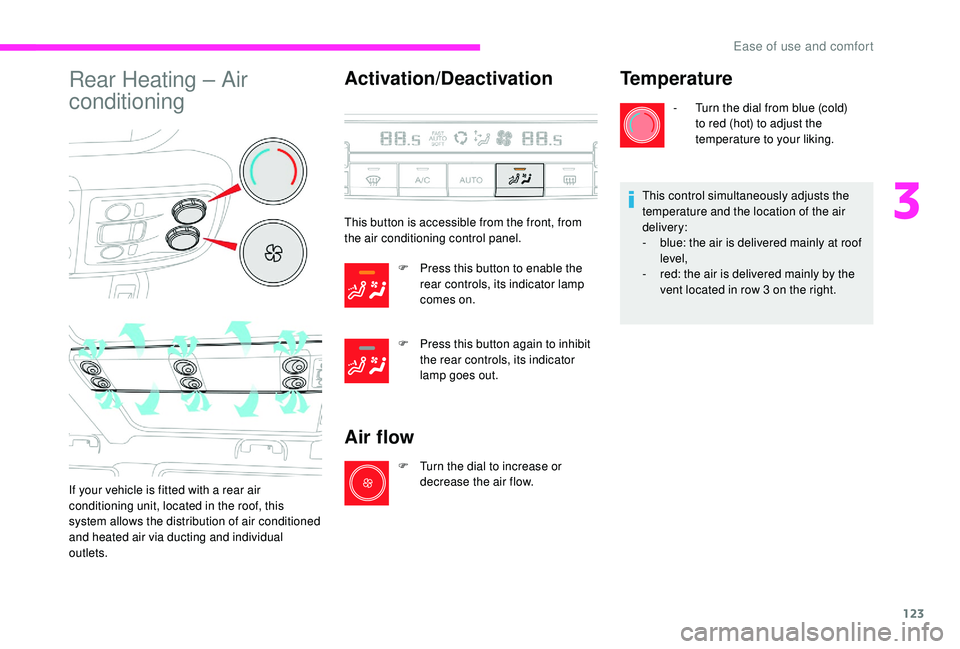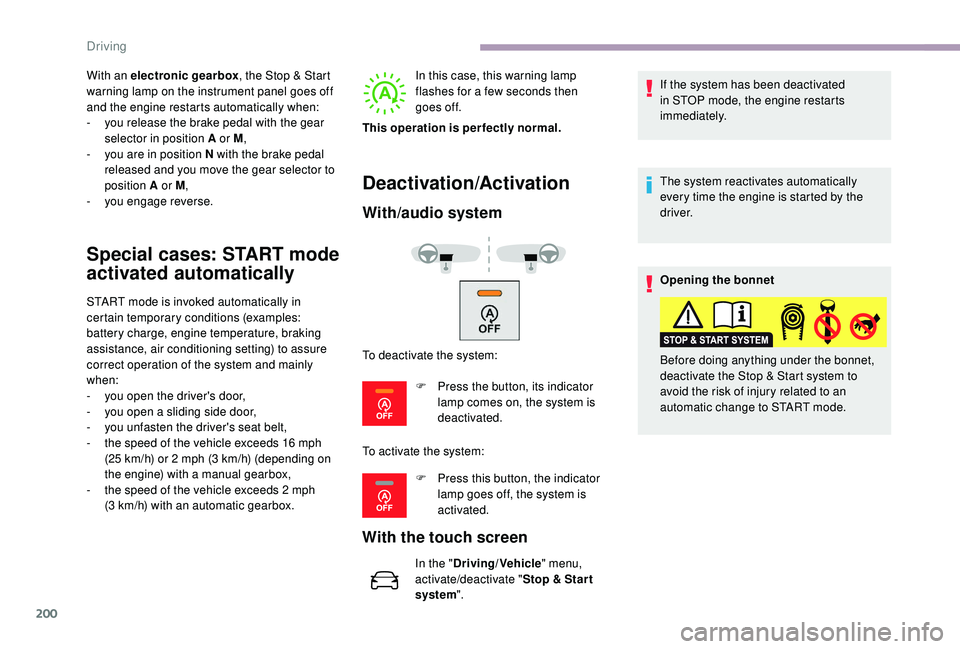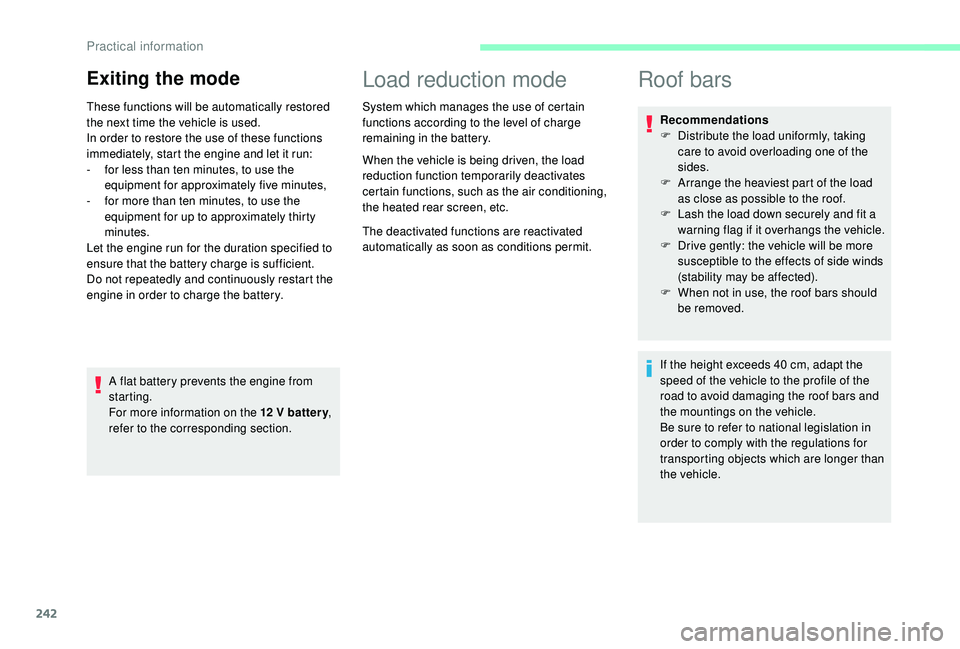air condition CITROEN DISPATCH SPACETOURER 2018 Handbook (in English)
[x] Cancel search | Manufacturer: CITROEN, Model Year: 2018, Model line: DISPATCH SPACETOURER, Model: CITROEN DISPATCH SPACETOURER 2018Pages: 400, PDF Size: 16.99 MB
Page 121 of 400

119
Air flow
F Press this button to increase the air f low.
F
P
ress this button to decrease
the air flow.
The symbol for air flow (fan blade) appears. It
fills or empties progressively according to the
value requested.
Recirculation of the interior air
The intake of exterior air prevents the formation
of condensation on the windscreen and side
windows.
The recirculation of interior air isolates the
passenger compartment from exterior odours
and smoke.
This allows hot or cold air to be delivered
quickly when required.
F
P
ress this button to recirculate the
interior air; the symbol appears
or its indicator lamp comes on
(depending on version).
F
P
ress this button again to allow
exterior air to enter; the symbol
disappears or its indicator lamp
goes off (depending on the
version you have).
Avoid prolonged use of air recirculation –
Risk of condensation and deterioration of
air quality!
Front demist – defrost
These markings on the control panel
indicate the control positions for
rapid demisting or defrosting of the
windscreen and side windows.
Manual air conditioning
F For air conditioning, press this button; its indicator lamp comes
on.
F
P
ut the air flow, temperature and distribution
controls to the dedicated marked position.
3
Ease of use and comfort
Page 122 of 400

120
Dual-zone automatic air
conditioning
The system starts again with the values in use
before it was deactivated.Heated windscreen and washer jets
For more information on the Wiper
control stalk
and in particular the heated
windscreen and washer jets, refer to the
corresponding section.
With Stop & Start, when demisting/
defrosting has been activated, STOP
mode is not available.
Door mirrors demist –
defrost
Switching on
F Press this button to demist / defrost the door mirrors; its
indicator lamp comes on.
Switching off
Demisting/defrosting switches off automatically
to prevent excessive electrical consumption.
F
I
t is possible to stop the
demisting/defrosting operation
before it is switched off
automatically by pressing this
button again; its indicator lamp
goes out.
F
P
ress this button to demist or
defrost the windscreen and side
windows as quickly as possible.
The system automatically manages the air
conditioning, air flow and air intake, and
provides optimum distribution towards the
windscreen and side windows. F
T
o stop, press this button again
or on AUTO.
Ease of use and comfort
Page 124 of 400

122
Advice
In order for these systems to be fully effective,
follow the operation and maintenance
guidelines below:
F
T
o ensure that the air is distributed evenly,
keep the external air intake grilles at the
base of the windscreen, the nozzles, the
vents, the air outlets and the air extractor
located in the rear free from obstructions.
F
D
o not cover the sunshine sensor, located
at the top of the windscreen; this is used
for regulation of the air conditioning
system.
F
O
perate the air conditioning system for
at least 5
to 10 minutes, once or twice a
month to keep it in per fect working order.
F
T
o prevent misting or deteriorating air
quality inside the passenger compartment,
you should not deactivate the system for
too long and avoid extended operation of
the air recycling system when driving.
F
E
nsure that the passenger compartment
filter is in good condition and have the
filter elements replaced regularly.
We recommend the use of a combined
passenger compartment filter. Thanks to
its special active additive, it contributes
to the purification of the air breathed by
the occupants and the cleanliness of the
passenger compartment (reduction of allergic
symptoms, bad odours and greasy deposits). If after an extended stop in sunshine,
the interior temperature is very
high, first ventilate the passenger
compartment for a few moments.
Put the air flow control at a setting high
enough to quickly change the air in the
passenger compartment.
The air conditioning system does not
contain chlorine and does not present
any danger to the ozone layer.
The condensation created by the air
conditioning results in a discharge of
water under the vehicle which is per fectly
normal.
Stop & Star t
The heating and air conditioning systems
only work when the engine is running.
To maintain a comfortable temperature
in the passenger compartment, you can
temporarily deactivate the Stop & Start
system.
For more information on Stop & Star t ,
refer to the corresponding section.
F T
o ensure correct operation of the air
conditioning system, you are also advised
to have it checked regularly according
to the Maintenance and Warranty Guide
recommendations.
F
I
f the system does not produce cold air,
switch it off and contact a CITROËN dealer
or a qualified workshop.
When towing the maximum load on a steep
gradient in high temperatures, switching off the
air conditioning increases the available engine
power and so improves the towing ability.
Vents
To close the vent, move the control outwards.
You may feel slight resistance.
Ease of use and comfort
Page 125 of 400

123
Rear Heating – Air
conditioning
If your vehicle is fitted with a rear air
conditioning unit, located in the roof, this
system allows the distribution of air conditioned
and heated air via ducting and individual
outlets.
Activation/Deactivation
This button is accessible from the front, from
the air conditioning control panel.F
P
ress this button to enable the
rear controls, its indicator lamp
comes on.
F
P
ress this button again to inhibit
the rear controls, its indicator
lamp goes out.
Air flow
F Turn the dial to increase or decrease the air flow.
Temperature
- Turn the dial from blue (cold) to red (hot) to adjust the
temperature to your liking.
This control simultaneously adjusts the
temperature and the location of the air
delivery:
-
b
lue: the air is delivered mainly at roof
level,
-
r
ed: the air is delivered mainly by the
vent located in row 3
on the right.
3
Ease of use and comfort
Page 139 of 400

137
Screenwash/headlamp wash
level low
In the case of vehicles fitted with
headlamp washers, when the fluid
reser voir low level is reached this
warning lamp comes on in the
instrument panel, accompanied by
an audible signal and a message.
The warning lamp comes on when the ignition
is switched on, or every time the stalk is
operated, until the reser voir is refilled.
Next time you stop, refill the screenwash/
headlamp wash reservoir.
Heated windscreen and
washer jets
(depending on country of sale)
This function heats the windscreen and washer
jets under cold conditions. In area 1
, the heating frees the wiper blades
when they are stuck by snow or ice.
In area 2 , the heating improves visibility by
avoiding the accumulation of snow when the
wipers are operating.
Switching on
With the engine running, press this
button; its indicator lamp comes on.
Windscreen and headlamp
wash
On vehicles fitted with automatic air
conditioning, any action on the windscreen
wash control results in temporary closing
of the air intake to avoid odours inside the
passenger compartment.
F
P
ull the wiper stalk towards you. The
windscreen wash, then the windscreen
wipers, operate for a pre-determined time.
The headlamp wash is only activated if the
dipped headlamps are on and the vehicle is
moving .
With daytime running lamps, to activate the
headlamp wash, position the lighting stalk in
the dipped beam position. The period of operation depends on the
exterior temperature.
Pressing this button again switches the
function off; its indicator lamp goes off.
4
Lighting and visibility
Page 147 of 400

145
Grip control
Special patented traction control system which
improves traction on snow, mud and sand.
This system, the operation of which has been
optimised for each situation, allows you to
manoeuvre in most conditions of poor grip
(encountered during touring use).
The accelerator pedal should be pressed
sufficiently to allow the system to use the power
of the engine. Operation at high engine speeds
is completely normal.
Standard (ESC)
F Place the knob in this position.
ASR/DSC
These systems offer increased safety
in normal driving, but they should not
encourage the driver to take extra risks or
drive at high speed.
It is in conditions of reduced grip (rain,
snow, ice) that the risk of loss of grip
increases. It is therefore important for your
safety to keep these systems activated in
all conditions, and particularly in difficult
conditions.
The correct operation of these
systems depends on obser vation of
the manufacturer's recommendations
regarding as much the wheels (tyres and
rims), braking and electronic components
as the assembly and repair procedures
used by CITROËN dealers.
To benefit in full from the effectiveness
of these systems in wintry conditions,
the vehicle must be fitted with four snow
tyres, allowing the vehicle to retain neutral
behaviour on the road.
A five-position selector knob allows you to
choose the setting best suited to the driving
conditions encountered.
An indicator lamp associated with each mode
comes on to confirm your choice.
Associated with all-seasons Peak
Mountain Snow Flake tyres, this system
offers a compromise between safety, grip
and traction. These tyres are efficient in
winter and summer conditions. This mode is calibrated for a low level of wheel
spin, based on the different levels of grip
normally encountered on the road.
Every time the ignition is switched off, the
system automatically resets to this mode.
5
Safety
Page 153 of 400

151
Instructions for children
Use a suitable child seat, if the passenger
is less than 12 years old or shorter than
one and a half metres.
Never use the same seat belt to secure
more than one person.
Never allow a child to travel on your lap.
For more information on Child seats , refer
to the corresponding section.
In case of impact
Depending on the nature and seriousness
of the impact, the pyrotechnic may be
deployed before and independent of the
airbags. Deployment of the pyrotechnics
is accompanied by a slight discharge of
harmless smoke and a noise, due to the
activation of the pyrotechnic cartridge
incorporated in the system.
In all cases, the airbag warning lamp is lit.
After an impact, get the seat belt system
checked and if necessary have it replaced
by a CITROËN dealer or a qualified
workshop.AirbagsThe airbags do not operate when the
ignition is switched off.
This equipment will only deploy once. If a
second impact occurs (during the same or
a subsequent accident), the airbag will not
be deployed again.
Impact detection zones
A. Frontal impact zone.
B. S ide impact zone.
System designed to contribute towards
improving the safety of passengers (with the
exception of the centre seat in rows 2
and
3, depending on your vehicle) in the event of
violent collisions. The airbags supplement the
effect of the seat belts with force limiter.
If a collision occurs, the electronic detectors
record and analyse the front and side impacts
sustained in the impact detection zones:
-
i
n the event of a serious impact, the airbags
are deployed instantly and contribute
towards better protection of the passengers
(with the exception of the centre seat in
rows 2
and 3, as applicable); immediately
after the impact, the airbags deflate rapidly
so that they do not hinder visibility or the
exit of the passengers,
-
i
n the case of a minor or rear impact or in
certain roll-over conditions, the airbags
may not be deployed; the seat belt
alone contributes towards ensuring your
protection in these situations.
5
Safety
Page 202 of 400

200
With an electronic gearbox, the Stop & Start
warning lamp on the instrument panel goes off
and the engine restarts automatically when:
-
y
ou release the brake pedal with the gear
selector in position A or M ,
-
y
ou are in position N with the brake pedal
released and you move the gear selector to
position A or M,
-
y
ou engage reverse.
Special cases: START mode
activated automatically
START mode is invoked automatically in
certain temporary conditions (examples:
battery charge, engine temperature, braking
assistance, air conditioning setting) to assure
correct operation of the system and mainly
when:
-
y
ou open the driver's door,
-
y
ou open a sliding side door,
-
y
ou unfasten the driver's seat belt,
-
t
he speed of the vehicle exceeds 16 mph
(25
km/h) or 2 mph (3 km/h) (depending on
the engine) with a manual gearbox,
-
t
he speed of the vehicle exceeds 2 mph
(3
km/h) with an automatic gearbox. In this case, this warning lamp
flashes for a few seconds then
goes off.
Deactivation/Activation
With/audio system
With the touch screen
In the " Driving/Vehicle " menu,
activate/deactivate " Stop & Star t
system". If the system has been deactivated
in STOP mode, the engine restarts
immediately.
This operation is perfectly normal.
To deactivate the system:
F
P
ress the button, its indicator
lamp comes on, the system is
deactivated.
To activate the system: F
P
ress this button, the indicator
lamp goes off, the system is
activated. The system reactivates automatically
every time the engine is started by the
driver.
Opening the bonnet
Before doing anything under the bonnet,
deactivate the Stop & Start system to
avoid the risk of injury related to an
automatic change to START mode.
Driving
Page 236 of 400

234
Under-inflation detection
This system automatically monitors the tyre
pressure while driving.
The system monitors the pressure in all four
tyres, once the vehicle is moving.
It compares the information given by the
wheel speed sensors with reference values,
which must be reinitialised after ever y tyre
pressure adjustment or wheel change.
The system triggers an alert as soon as it
detects a drop in the pressure of one or more
tyres.
The tyre under-inflation detection system
does not replace the need for vigilance on
the part of the driver.
This system still requires you to check
the tyre inflation pressures (including
the spare wheel) every month as well as
before a long journey.
Driving with under-inflated tyres impairs
handling, extends braking distances and
causes early tyre wear, particularly in
adverse conditions (heavy loads, high
speeds, long journeys). Driving with under-inflated tyres
increases fuel consumption.
The tyre pressure specifications for your
vehicle can be found on the tyre pressure
label.
For more information on the
Identification markings , refer to the
corresponding section.
Tyre pressures should be checked when
the tyres are "cold" (vehicle stopped for
1
hour or after a journey of less than
6
miles (10 km) at moderate speeds).
Other wise (when hot), add 0.3
bar to the
pressures shown on the label.
Snow chains
The system does not have to be
reinitialised after fitting or removing snow
chains.
Spare wheel
The steel spare wheel does not have an
under-inflation detection sensor.
Under-inflation alert
This warning is indicated by fixed
illumination of the lamp, an audible
signal and, depending on the
equipment installed, a message
displayed on the screen.
F
R
educe speed immediately, avoid excessive
steering movements and sudden braking.
F
S
top the vehicle as soon as it is safe to do
so.
The loss of pressure detected does not
always cause visible bulging of the tyre.
Do not satisfy yourself with just a visual
check.
F
I
n the event of a puncture, use the
temporary puncture repair kit or the spare
wheel (depending on equipment),
or
F
i
f you have a compressor, such as the one
in the temporary puncture repair kit, check
the pressures of the four tyres when cold,
or
F
i
f it is not possible to make this check
immediately, drive carefully at reduced
speed.
Driving
Page 244 of 400

242
Exiting the mode
These functions will be automatically restored
the next time the vehicle is used.
In order to restore the use of these functions
immediately, start the engine and let it run:
-
f
or less than ten minutes, to use the
equipment for approximately five minutes,
-
f
or more than ten minutes, to use the
equipment for up to approximately thirty
minutes.
Let the engine run for the duration specified to
ensure that the battery charge is sufficient.
Do not repeatedly and continuously restart the
engine in order to charge the battery.
A flat battery prevents the engine from
starting.
For more information on the 12
V batter y,
refer to the corresponding section.
Load reduction mode
System which manages the use of certain
functions according to the level of charge
remaining in the battery.
When the vehicle is being driven, the load
reduction function temporarily deactivates
certain functions, such as the air conditioning,
the heated rear screen, etc.
The deactivated functions are reactivated
automatically as soon as conditions permit.
Roof bars
Recommendations
F D istribute the load uniformly, taking
care to avoid overloading one of the
sides.
F
A
rrange the heaviest part of the load
as close as possible to the roof.
F
L
ash the load down securely and fit a
warning flag if it overhangs the vehicle.
F
D
rive gently: the vehicle will be more
susceptible to the effects of side winds
(stability may be affected).
F
W
hen not in use, the roof bars should
be removed.
If the height exceeds 40
cm, adapt the
speed of the vehicle to the profile of the
road to avoid damaging the roof bars and
the mountings on the vehicle.
Be sure to refer to national legislation in
order to comply with the regulations for
transporting objects which are longer than
the vehicle.
Practical information